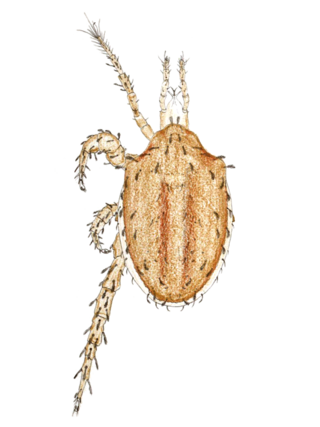Hypoaspis is a genus of mites in the family Laelapidae.

Mesostigmata is an order of mites belonging to the Parasitiformes. They are by far the largest group of Parasitiformes, with over 8,000 species in 130 families. Mesostigmata includes parasitic as well as free-living and predatory forms. They can be recognized by the single pair of spiracles positioned laterally on the body.

The Laelapidae are a family of mites in the order Mesostigmata. The family is also referred to in the literature as Laelaptidae, which may be the correct spelling.

Macrochelidae is a family of mites in the order Mesostigmata.

Pachylaelapidae is a family of mites in the order Mesostigmata. There are about 16 genera and more than 200 described species in Pachylaelapidae.
Elaphrolaelaps is a genus of mites in the family Pachylaelapidae. There are about eight described species in Elaphrolaelaps.
Pachylaelaps is a genus of mites in the family Pachylaelapidae. There are more than 50 described species in Pachylaelaps.

Ameroseius is a genus of mites in the family Ameroseiidae. There are more than 60 described species in Ameroseius.
Brontispalaelaps is a genus of mites in the family Ameroseiidae. There are at least two described species in Brontispalaelaps.

Hattena is a genus of mites in the family Ameroseiidae. There are about 10 described species in Hattena.

Neocypholaelaps is a genus of mites in the family Ameroseiidae. There are more than 20 described species in Neocypholaelaps.
Sertitympanum is a genus of mites in the family Ameroseiidae. There are about eight described species in Sertitympanum.
Ascidae is a family of mites in the order Mesostigmata.
Antennoseius is a genus of mites in the family Ascidae. As of 2021, it comprised 59 species mostly in subgenera Antennoseius and Vitzthumia, as well as six species not assigned to a subgenus.

Sinoseius lobatus is a species of mite in the family Ameroseiidae. It was first described in 1995 by Bai, Gu, and Fang.

Blattisociidae is a family of mites in the order Mesostigmata.
Asperolaelaps is a genus of mites in the family Ameroseiidae. There are at least two described species in Asperolaelaps.

Kleemannia is a genus of mites in the family Ameroseiidae. There are more than 20 described species in Kleemannia.
Melicharidae is a family of mites in the order Mesostigmata.

Uropodina is an infraorder of mites in the order Mesostigmata.










